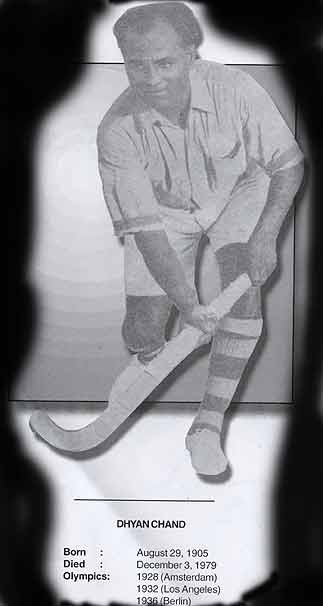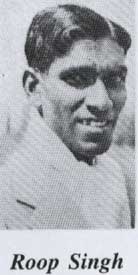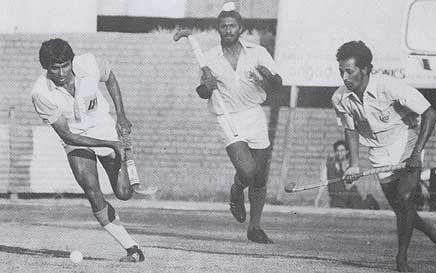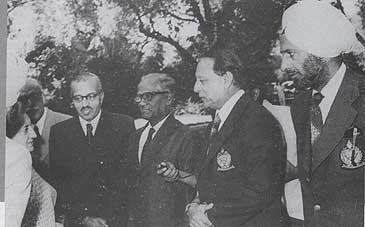Great
Indian Olympians
THE STAR
EXTRAORDINAIRE
BALBIR
SINGH

It
was time for India's tryst with destiny. In 1947, the nation was in turmoil. Freedom
from 200 years of British rule did not come without its share of trauma and tragedy.
The country was partitioned on religious lines and the Islamic Republic of Pakistan
was created in the northern and eastern parts of the coun-try. A large-scale migration
of population took place from across the new border. The partition was a painful
affair, solemnised amidst unprecedented violence, mayhem and distrust. Every hockey
player of that era had his own tale of woe to narrate.
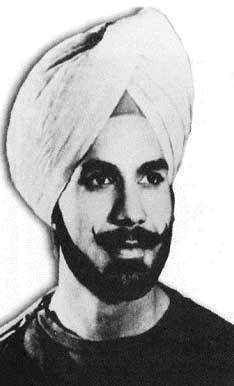
Balbir
in his mid 20s.
Lahore, the nerve centre
of the sub-continent's hockey, the city that gave seven of the 18-member Indian
team for the Berlin Olympics, had become a part of Pakistan. Many hockey giants
living in Lahore had to migrate to India and vice-versa. Many players of the game
from Central India choose to settle in Pakistan. That included Y.M. Yousuf, who
later became an Afghan citizen. The question that naturally arose was whether
India would be able to maintain its suzerainty without these great players.
Another
related development pertains to the Anglo-Indians. Though they comprised a minus-cule
of the population in a country of about 350 million, they constituted the very
core of Indian hockey in the pre-World War era. Nine out of sixteen stars of India's
first Olympic team to Amsterdam in 1928, belonged to this community. With the
new political developments, a substantial chunk of them had an opportunity to
seek greener pastures. They left India in droves and settled in England, Australia,
Canada, New Zealand and elsewhere. Great lovers and practitioners of the game
that they were, the magnitude of loss to Indian hockey was enormous.
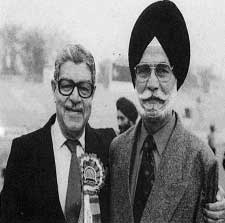
Balbir
Singh with Keshav Dutt
It was under the backdrop
of such depletion of talent and a scenario in which the wounds of partition were
far from erased from the collective consciousness of the country, that India started
its campaign in the 1948 London Olympics. There was enormous pressure to keep
the country's image intact, an image so painstakingly acquired amidst a cesspool
of adversities in the 20s and maintained right until then. Further the powerful
British team, who till then refrained from playing Olympics hockey, was back in
the fray. The challenge India faced was formidable.
It is under
this historical backdrop that Balbir Singh played an outstanding role in lifting
India to lofty heights. Not many would have expected the 24-year old centre-forward
to inherit the legacy of Dhyan Chand at the London Olympics so easily and elegantly.
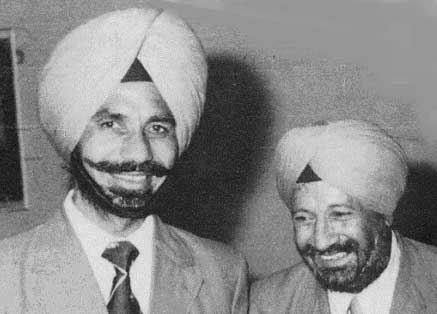
Balbir
Singh with G.S. Bodhi, coach, 1975 World Cup that India won.
The
early trapping of the man who was to decide the outcome of two more Olympics was
evident in the first match he played at London. Although he was not in the first
eleven of the opening game against Argen-tina, when a player named Regie fell
ill this Punjab player was fielded in a match against Argentina. The newcomer
turned the match single-handed! Ripping apart the defence, he scored six goals
and steamrolled the Latin Americans to a 9-1 defeat. Thus, he achieved a rare
feat of scoring a goal on debut, and making a hat- trick. For a man who later
at-tained a hat-trick of Olympic golds, the goal spree proved to be the harbinger
of things to come. However, he had to wade through many uncertain phases before
carving a niche for himself in the world-class hockey.
The first chance to
establish his power over the game and prove himself came in the next match itself.
He was asked to get ready for an encounter against Spain. But just when he was
entering the ground, he was asked to stay back and the manager Pankaj Gupta replaced
him with Nandy Singh. Like his role model Dhyan Chand who used to look over every
humili-ation inflicted on him in the interest of sports, he did not utter a single
word against the decision that robbed him of a chance to prove his calibre. The
same fate befell him during the semi-final against Holland. He was among the first
eleven and had also entered the ground. But just as he was about to bully-off,
captain Kishan Lal asked him to make way for Glacken. What made the managers P.C.
Chatterjee and Pankaj Gupta to force the captain to replace Balbir Singh, that
too much against his will, is still a mystery.
Yet, perfect gentleman as he
was, Balbir Singh walked back to the dressing room quietly. When he was again
put among the first eleven for the final, he nurtured doubts about him being allowed
to play. But thankfully nothing of the sort occurred in the next match. Grabbing
the opportunity with both hands, he proved his superior talent by responding in
the only way a champion sportsman would. He let his stick do the talking. Latching
on to passes from captain Kishan Lal and inside-forward Kanwar Digvijay Singh
'Babu', he pumped both the goals India scored before half-time. This paved the
way for what can be described as a historic Indian victory over the masters, with
four goals scored in its favour while conceding none.
Hockey is a team game
yet so skilful were players like him that they made it seem like a one-man show.
Such were his skills and predominance that India managed only single-goal-margin
victories in the matches in which he had not played. Independent India's first
Olympic gold settled all pre-tournament speculations at rest. Partition or no,
talent drain or no, India was as invincible as ever. The victory gave India an
identity, a pride and a springboard for many more victories to follow.
Balbir
Singh received immense praise but none of it would affect him or make him vain.
Instead, it motivated him to scale lofty heights. The chance to do so came during
the next Olympics. At Helsinki in 1952, glory beckoned Balbir Singh. His continued
his goal-spree in the National Championships, leading India to an all-win visit
to Afghanistan truly put him on the spotlight. Unlike the London edition, not
much socio-political significance could be attached to India's campaign for Helsinki
as it had already proved its potential in 1948. Yet, prestige was at stake and
India had to defend the title. For a country that had no prospects in any other
discipline, hockey alone had to meet the aspirations of the millions of its sports
lovers. A heavy responsibility to shoulder indeed.
A strange format posed a
problem of a different kind for the leading teams at Helsinki. India, like the
other three semi-finalists, was directly seeded in the quarterfinal. That meant
that they were given a chance to play only three matches, all knockout punches,
all precarious with no time left for recovery or remedy. Hence, enormous pressure
was on the forwards to score goals to avoid stumbling at any stage.
As the
flag-bearer of the Indian contingent at the opening ceremony, Balbir Singh knew
this.
He was cut for such a role, but he was also worked up as some cynics
doubted his form,
since his team had lost both the All India Police Games and
the National Championship that year. The first match against Austria, which India
won laboriously at 4-0, did not give any indication of things to come. He could
send the ball home only once. A heavy dose of
dressing down by the team management
seemed to have pumped ounces of adrenaline in him as was evident from his subsequent
performances.
In the semi-final against the masters Great Britain, Balbir Singh
came on his own. All three goals India scored came from his ex-traordinary ball
sense, artis-tic but limited dribble and first-touch scoring shots. A second hat-trick
in only his fourth Olympic cap and five goals against two-time goldmedallist Britain
in only two matches proved the stuff of which the champion was made.
This alerted
the finalist Holland. Always a defence exponent, they put two defenders to contain
the marauding Balbir Singh. Incensed Balbir Singh replied in style. He made mincemeat
of the de-fence, with excellent support from wingers Rajagopal and Raghubir Lal.
He alone scored five goals. Riding on his form, India romped home to a memorable
6-1 victory, India's fifth straight Olympic gold. This included a hat trick, and
a victory in three of the five matches played - a record which remains unbroken
till date.
It is his expertise inside the circle that had many comparing him
with the legendary Dhyan Chand. "Ball with Balbir Singh in the circle, and
the defence is paralysed," exclaimed his peer Keshav Dutt. Never would Punjab
Hockey Association field a team without him. Hardly would he get any respite from
matches. Come what may - occasional fitness hassles, bouts of fever or domestic
compulsions, Balbir Singh had to be a part of the team. Officials would visit
his house and force him to play. He obliged them every time and that too with
nearly fantastic results.

The
victorious Indian world cup team (1975) in fun hockey with film stars.
In
the Xllth Olympiad at Melbourne, Balbir Singh fractured his hand. After scoring
five goals against Afghanistan in the opening match, a rasping drive from the
right back hit his fingers when he boldly tried to intercept it. He was ruled
out of other matches. This rattled the Indian management. Balbir Singh himself
rued his fate. If it was some mischief in 1948 that left him out for two matches,
eight years later it was bad luck that kept him from playing in all the matches.
He remained a mere spectator in the matches against United States of America and
Singapore. Meanwhile, his injury was kept a closely-guarded secret. He was asked
to keep his injured hand always covered. This also had a reason. He was the main
scorer in those days. In fact, only two years earlier, during a tour to Malaysia,
he had gathered as many as 83 of the 121 goals scored in 16 matches; a year later
in the New Zealand-Australia tour, his bag was full with 141 of the team's 203
goals in 38 matches. Hence, the opposition had made it a part of their strategy
to depute two defenders to contain him. If the news of his injury would have spread,
the opponents would have gained much more confidence than they did with Udham
Singh occupying the top scorer's spot. Such was his stature that even when injured,
he had a significant role to play - of imparting a psychological boost to his
team.
What was expected did happen in the semi-final against Germany. Balbir
Singh, bolstered by doses of painkillers, attracted two defenders. As a result
Udham got a lot of free space to push his goals through. Subsequently, it was
his lone goal that made India the winner. In the final too, the Pakistanis - it
was the first ever meet between the two gifted neighbours - had two defenders
hounding on him which eased the pressure on other forwards. One shudders to imagine
the fate of rival teams had Balbir Singh been fit to score. But it was not to
be. In this match a penalty corner conversion by Randhir Singh Gentle led India
to its sixth straight gold. Balbir Singh recollected later, "For me, on one
hand was the agony of pain, on the other the ecstasy of winning glory, of triumph.
The latter outweighed my pain. It now mattered little even if I lost both my limbs."
His
post-Olympic career too was colourful. He changed his employment from Punjab Police
to accept the leadership of the Sports Department of the Punjab government. He
innovated and implemented many realistic schemes that laid the foundation for
the state to emerge as the strongest sporting province of India. Many brief stints
as national coach, selector and manager marked this spell. Worthy of mention is
that under his managerial capacity, India won its only world Cup title in 1975.
After this success, the elated Balbir Singh penned his autobiography The Golden
Hat trick: My Hockey Days. When the Government of India instituted the first civilian
award, 'Padamshree' in 1957, he deservedly was the first one to receive it. Balbir
Singh now lives with his son in Canada.

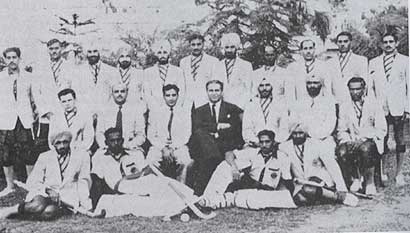
Victorious
1956 Olympic Hockey Team
HOCKEY
KINGS
BALKRISHAN
SINGH - COACH TO THE CORE
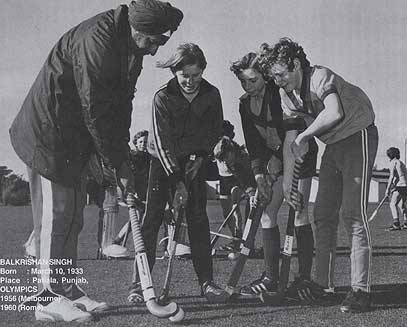
Some
unique aspects distinguish the life and career of Balkrishan Singh from that of
the five hockey legends portrayed so far. Unlike these luminaries, who continued
to be on the payrolls of their employers after they had hung their boots, Balkrishan
chose to serve the game in a different but professional and purposeful way even
as many years of hockey were left in him. The times they lived in and played the
game were different and the demands of their lives were not common. Yet, comparisons
between them yield interesting insights into the lives of these personalities.
Dhyanchand
became the first chief coach of the National Institute of Sports (NIS), Patiala,
India, only after his retirement from the Indian Army; After three Olympics, Balbir
Singh discharged his service in Punjab Police before shifting to another department
in the same State; Leslie Claudius too continued in Customs long after he had
retired from professional hockey; the career graph of Shankar Laxman too was no
different; Md. Shahid continues working in the Indian Railways. No doubt all these
players dabbled in spells of national duty as selector, manager and even coach,
but for them the mainstay remained their service, which was not always related
to hockey. The career graph of Balkrishan was, however, different in so far as
he resigned from the Indian Railways even as he was in peak form and preferred
to join NIS as 2 coach where he served for three decades. That gave the distinguishing
aura to his highly successful career as a hockey player.
From a historical
perspective, this continuity placed him in the unique position of being a player
who had been in touch with all the five legends outlined in this book - Dhyan
Chand was his mentor in NIS for six years; he played alongside Claudius, Laxman
and Balbir Singh; and he coached Shahid for two of the three Olympics played by
him. Therefore, in studying his career one can traverse through the vicissitude
of Independent India's hockey history.
It is true that unlike the other five
hockey personalities, each of whom had figured in three Olympics, he played Olympics
only twice - in 1956 and 1960. But he compensated this in more than one way by
becoming the only one from the elite group to coach Indian teams for four Olympics.
Even Dhyan Chand did not coach any Olympic team.
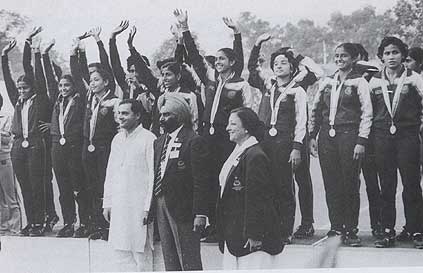
Indian
Girls won their maiden Asian games Gold in 1982 when Balkrishan was the coach
AND he gets the toast for that feat (below)

Balkrishan
was born in March 1933. His career could not but have been such an illustrious
one as he was born in a sport-loving family and grew up in a sports-conscious
city, Patiala. His father, Brigadier Dalip Singh, in the true traditions of the
Indian Army, excelled in sports and was one of the greatest track and field athletes
of his times. He participated in the 1924 Paris Olympics even before Indian hockey
entered this global arena. He was seen in action in the next Olympics too - a
remarkable achievement for someone who did not face the rigours of coaching as
it existed in many other countries during the period. He secured eighth position
with a jump of 21 feet 2 inches.
Balkrishan's schooling was accomplished at
his hometown Patiala after which he joined the famous F.C College, Lahore, for
graduation. His father being an alumnus of the great institution put him in the
right track when he advised his young son, "I command respect in the college
through sports. You must keep my name by way of excelling in sports". He
took the words to his heart and like his father became a grand double Olympian,
albeit in a different sport, but not before proving his expertise in athletics.
When
he was still under 16, he broke the Punjab University record in hop, stop and
jump in 1949, and became the inter-university champion in 1950. He also broke
the University high-jump record. At the same time, he represented the university
in hockey from 1950 to 1954. In 1954, he got the first call to join the national
team. He obtained the country's colours in the International Hockey Festival at
Warsaw, Poland. Around the same time, he joined the top-notch Indian Railways.
That gave him enormous scope to take part and prove his worth through various
tournaments.
Even amidst tough competition against such established
defenders of fame as Shanta Ram, Murthy and Swaroop Singh, young Balkrishan could
secure a berth for himself in the 1956 Olympics team. His sparkling play in the
Aga Khan Cup a year earlier paved the way for Olympic entry. At Melbourne, he
played all matches except the final, giving way to Bakshish Singh. The sight of
the tall, robust player who was a picture of confidence evoked awe in the rival
forwards in all the matches he played. So enamoured were the Australians by his
majes-tic and flawless tactics that he almost emerged a cult figure in later years.
Two
years later, in the third Asian Games, his game was in full flow. By then he had
led the Railways to the victor's podium twice, in 1957 and 1958, beating formidable
Bombay in its own backyards on both occasions. His ambition of playing against
Pakistan, which eluded India at Melbourne, was fulfilled here. He played the best
match of his life against Pakistan. He and Bakshish Singh foiled every free-flowing
attack of Pakistan forwards in the final. The match ended in a goal-less draw
though Pakistan was declared winner on the basis of goal average.
With one
more victory for his captaincy in the National Championship, this time over Services
at Hyderabad, he became an automatic choice for the 1960 Rome Olympics. Here again,
Pakistan became the champion. The two defeats shook the soul of young Balkrishan,
rever-berations of which he could feel even after 40 years had rolled by. For
India this was a time of introspection. A manifestation of this was the emerging
awareness for scientific training and the setting up of NIS. Along with hockey
stars of the day, Dharem Singh, Charanjit Singh and Charles Stephen, Balkrishan
underwent one-year training in coaching in the NIS. Inspired by the personality
of the chief coach Dhyan Chand, the first-batch incumbent topped the course with
93 percent marks.
He returned to Railways and led his institution to another
title at Hyderabad, beating the defending champion, Services. Then came the call
of his life, an offer to join the NIS faculty. It was a full-time job. He had
to decide between competitive hockey and the new offer. He preferred the latter.
The momentous decision was taken in a split second as he had by then developed
a liking for strategy, tactics and all the mind-games that goes along with coaching.
With that his seven-year affliction with international hockey came to end. Another
glorious chapter that would endure for 31 years had commenced.
With Dhyan Chand
at the helm, sky was the only limit for this inquisitive youngster to enlarge
the horizons of his hockey knowledge. So impressed was Dhyan Chand by his abilities
that, a year before he retired he wrote in his confidential report, "I have
full faith in Balkrishan's ability. He is the finest young coach in the country
today." That was more than adequate foi the authorities to elevate him to
the post that Dhyan Chand adored till then. In the same year 1967, the Australian
government extended an invitation to him to offer expert counselling ir the country.
He gladly accepted the challenge and spent four and half months in Australia During
his stay, he visited every provincial capital for about a fortnight, and imparted
all the knowledge he had to schoolboys and girls as also to aspiring trainers.
He truly acted as the ambassador of India during that tour held under the aegis
of a cultural exchange programme
The trip was sponsored by Rothmans Sports
Foundation and he was paid a honorarium of US$ 400 per week, besides all other
expenses paid - a huge sum for a coach in amateur sports. More than the financial
aspect, what gladdened the heart of the 34-year old Balkrishai was when the then
Prime Minister of Australia, Mr. Malcolm Fraser, himself an hockey enthusiast
and umpire, chose to praise him. In his subsequent visit to India, he thanked
his counterpart Morarji Desai, in an official banquet, for sparing the services
of experts like Balkrishan to improve hockey in the country. Balkrishan also took
an All India Universities team to Australia in 1971. The team included such stars
as Surjit Singh, Baldev Singh, Ajit Singh,HJS Chimni, P.E.Kalaiah and V.Baskaran.
During this visit the team played eight matches with different Australian teams.
They won all the matches, scoring 65 goals and conceding just six. The year 1977
saw him visiting the same country once more.
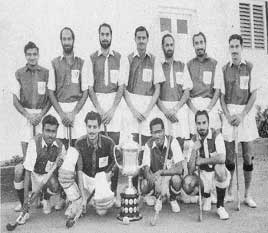
Balkrishan
Singh (second left) as a part of Northern Railways team that won the inter-railways
championship.
This Adelaide tour was sponsored
by a Federation Government grant and his coaching spells in schoolswas supported
by Savings Bank of S.A. and Coca-Cola. In all these tours, there was nodenying
the impact of his charisma - a blend of style, intellect and a forcible personality.
It
was due to the services rendered by experts like Balkrishan that the bond between
the two countries grew from strength to strength. India was regularly invited
for the Esanda tourna-ments held in Australia in the 80s and for the double-leg
4-Nations in the 90s. Women teams under Richard Charlesworth also visited India
many times.
His frequent visits to this continent and other parts of the world
enriched his domain of knowl-edge on a global scale. He wrote about Australia's
Charlesworth, a legendary hero in 80s, "Not many would be aware of the fact
that in all the leading competitions in which Charlesworth played as an inside
right, the Aussies lost. My conviction is that had he played as an inside left
in the Fifth World Cup (Bombay), Australia may well have won the trophy. Similarly,
in the 1984 Los Angeles Olympics and in the third PIA Champions Trophy at Karachi,
Australia could have performed better if he was in the inside left saddle. I do
not know if Aggis (the Aussie coach) will acquiesce with me or not, but the 'hockey
doctor' hopefully will agree to my assessment." In the sixth World Cup staged
at London, Charlesworth switched over to inside left position and Australia won
the World Cup trophy!
India too availed of his services. Even as he was under
35, he coached the 1968 Mexico Olympic team where India won a bronze medal but
it did not enthuse anybody, as the country was the defending champion then. Balkrishan
could not stop wondering why in this tourna-ment all the five goals that the great
Prithipal Singh scored against New Zealand through penalty corners were disallowed.
Incidents
of such nature, cataclysmic changes in the rules of the game, their haphazard
interpretation by umpires and the frequency with which they were changed by the
interna-tional governing body, Federation de Internationale Hockey was scrupulously
studied by Balkrishan. Once he wrote, "One of my students doing his master's
course in hockey wrote a thesis on penalty corner and by the time he completed
the job, the rule was changed, rendering his valuable work invalid." He wondered
when games like football, which has captured the imagination of people all over
the world has made only one change in rule in forty years, why were so many changes
brought about in this game. Based on analytical studies and research, he proposed
abolition of penalty corners and striking circle in order to make the game simple.
Not many agreed with him, but it exemplified his authority on the subject.
It
does not mean that he was dogmatic and against any change in rules. He welcomed
the abolition of penalty bully and introduction of artificial playing surfaces.
He was the first Indian coach to adopt the 4-4-2-1 style of field formation, which,
according to him, was more suitable for synthetic grounds. His brainchild 'total
hockey', which was often criticised by the purists for its defensive aspects,
has become the guiding paradigm of present-day coaches. The way he metamorphosed
the unique Indian traits in the concept of total hockey earned him many laurels
in the 80s and proved his caliber, dynamism and readiness to adapt to the changing
scenario. Being a strong protagonist of individual style and brilliance, without
which Indian hockey would not have attained the type of fame it did, he could
bring out the best in the likes of Md. Shahid, Merwyn Fernandes and others. He
once said, "Holland without Floris Bovelander and Pakistan without Shahbaz
Ahmed would mean an army without a general." He believed that Individual
efforts are conscious practices and are far ahead of mechanical practices which
coaches dole out during coaching sessions.
The synergy between tactical
acumen and individual talent that he so effectively in-grained in the concept
of 'total hockey' proved fruitful for India in many of its pres-tigious campaigns.
The significant role he played in developing Indian hockey can best be understood
on studying the cir-cumstances under which he was invited to train various Indian
teams. Every time he was invited for national coaching, those were invariably
distrust calls.
India's challenge in the 1980 Moscow Olympics was entrusted
to him after the country faced two lows - the first in the preceding 1976 Olympics
in which, for the first time, India had failed to win any medal, slipping to a
record low in ranking at seventh. The second was in the 1978 World Cup in which,
despite being the defending champion, India could not move beyond the fifth rank.
Balkrishan developed a young team that won the gold at Moscow. But he was not
sought in theWorld Cup that followed in a year and was recalled for the next Olympics
only after India fared poorly in the Bombay World Cup and in the Delhi Asian Games.
He used the spell to put together a girls' team in the Asian Games and they won
the title on their maiden entry. Till today, even after five editions, that remains
the only Asian gold for the Indian girls' team.

As
coach of the Asian XI Balkrishan receives the Pakistanis' warmth
In
the short span of a year, the men's team that he had so painstakingly developed
made it to the semi-finals at the Los Angeles Ol-ympics till a new system of considering
the
goal aggregate to decide pool rankings led India down. India ended the
campaign at fifth rank (beating Holland 5-2 in the last match). Yet he was axed.
His turn came in 1991 as India dished out another dismal fare, this time at the
Lahore World Cup.
In the run up to the 1992 Barcelona Olympics, his team set
up a tremendous record. It won all matches in annexing the title of the Sultan
Azlan Cup (1991) at Kuala Lumpur. That set the stage for sponsors to pour in.
In the Europe tour that followed, the team had a sponsor in Chhatisgarh Distillers
who awarded hefty sums for the 'Man of the Match' of all 15 tests India played.
12 wins and two draws out of the 15 matches in that tour created a great expectation,
but the players' greed and indiscipline spoilt the whole show at Barcelona - a
sad end to an illustrious career. But his efforts in giving India a meaningful
coaching perspective cannot be denied.
Had he ever been given a four-year tenure,
the history of Indian hockey would not have been as discouraging as it was in
the 70s and 80s. In the 1972 World Cup his team did not lose a single match, and
lost the title only due to the penalty shoot-out. Yet a new coach was found for
the 1975 World Cup. Why was he not in the scene even after the Moscow Olympics
gold is another question that would never be answered to satisfaction. If a master
theoretician in the mould of Balkrishan was not hailed at par with contemporary
greats such as Horst Wein, Paul Lissek, David Whitekar, Roelent Oltmans, Richard
Aggis, the fault lies with the system in which he had to work and not on the want
of anything in his persona.
Balkrishan coached various Indian teams within
a period of about a decade in six different spells. Never was a single assignment
allowed to last for more than two years. Yet, he did not lack behind in putting
all possible effort in imparting the best training. During the period India won
29 matches, drew nine and lost seven in the Olympics, World Cup, Champions Trophy
and the Asian Games. That four of the seven losses came in the Barcelona Olympics
alone is the only dark patch in an otherwise consistent career. That his teams
faced defeat against Pakistan only twice in 14 meetings further glorifies his
coaching prowess. His commentaries in the book 'World Hockey'are reflections of
his scholarly erudition of the game. He also had gift of the gab. His off-the-cuff
remark, "umpires are like watches, they never match" is an oft-quoted
phrase.
The above articles have
been taken with thanks from 'The Great Indian Olympians' by Gulu Ezekial &
K.Arumugam.
MENU
